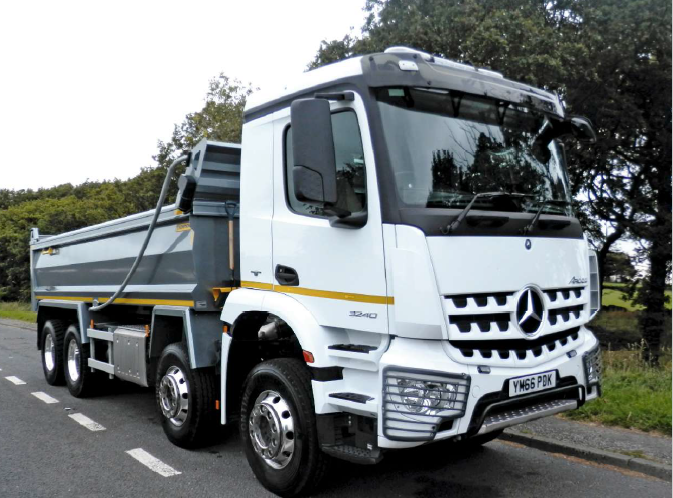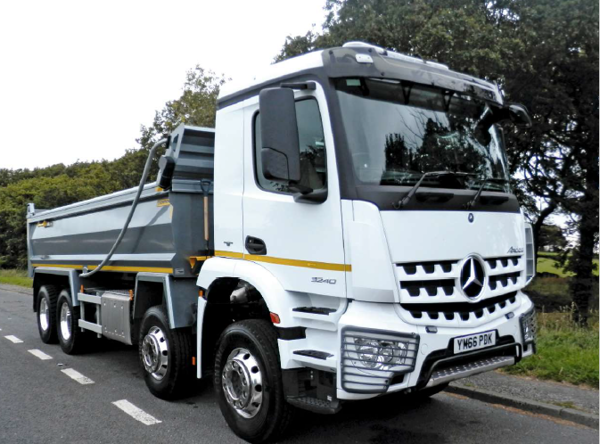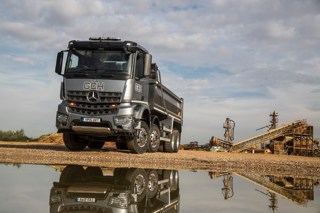Review
Arocs has an important role to play in the progress of Mercedes-Benz in the four-axle rigids sector.
It has to be acknowledged, by even the most ardent Mercedes-Benz heavy truck supporter, that in the world of four axle rigids (I have purposely left out three axles), their sales and, therefore, history in the sector has not been the most spectacular.
People may point to success in the low-cabbed Econic which is available in three- and four-axle form, so the introduction of the relatively new Arocs range has an important role to play in the development of sales for Mercedes-Benz and it’s with this in mind we had the opportunity to road test one of the more popular models in the very comprehensive range, a ‘typical’ eight-wheel tipper.
Arocs virtually covers the whole range of heavy truck requirements from two axles and multi-axles right the way up to the SLT tractor units at 250 gross combination weight.
While the latter may be at the more extreme end of heavy truck operations, the more mainstream 32-tonne four-axle range is just as broad.
A great example of this is the availability of 18 engine options encompassing four displacements – seven-litre, 10.7-litre, 12.8-litre and the top of the range 15.6-litre – with the two middle engines OM470/471 being Daimler’s latest second generation offerings.
The range of power outputs starts at 175 kW (240PS) with a peak torque of 1000 Nm, and at the other end of the power choices is the 460 kW (627PS) engine with a peak torque of 3000 Nm, which should be sufficient for most operations.
Matched to the wide range of power options is the Mercedes PowerShift 3 automated gearshifts with eight, 12 and 16 gears as well as six/nine speed manuals with pneumatic shifting assistance.
Of course, the mechanical system is only one side of the story with ‘offroad’ or ‘power’ driving programmes available at the time of ordering and both possess three driving modes, ‘offroad’, ‘standard’ and ‘manual’.
As might be expected the offroad is specifically designed for off-road use and supports a very power-oriented driving style at the push of a button.
Fitting between the engine and gearbox are a series of standard clutches as well as the option of a ‘Turbo Retarder Clutch’ which combines the functions of a hydrodynamic start-up clutch and a primary retarder in a single component delivering up to 720 kW of brake power directly from low speeds and is controllable via five levels on the steering column lever.
According to Mercedes there are two different ‘job-matched’ frames available for construction site/off-road use and for road use, with different frame tracks of 744mm and 834mm respectively and longitudinal members in three thickness of 7mm, 8mm and 9mm.
The wheelbases vary from 4250 to 6050mm and offer a combination of steel suspension and air suspension, the front and rear springs can be fitted with up to four leaf spring packages, five on the rear axle.
The purely road versions are equipped with steel suspension on the front axle and four-bellow air suspension on the rear axle of the wide frame.
Axle plated weight capacities range from 7.1 tonnes to a maximum 10 tonnes dependent on the position on the chassis.
For example, our test vehicle had 7.1 tonnes on the front two and 9.5 tonnes on the rear two, giving a 19-tonne bogie capacity.
There are nine cabs available in the range, starting at the ClassicSpace S-cab to the BigSpace L-cab encompassing three different lengths: S-cabs at 1700mm, M-cabs at 2000mm and L-cabs at 2300mm plus two widths 2300mm and 2500mm and various trim levels offering variations in space and stowage facilities.
One interesting choice is the ability to choose the engine tunnel height on the 2300mm-wide cabs to either 170mm or 320mm, while the wider 2500mm cab has a flat floor option.
Operators have a choice of a ‘standard engine brake’ or a high performance version delivering up to 480kW of braking, around 35% greater than the standard helping to reduce service brakes.
There is also the normal array of electronic-based braking system, such as ABS, ASR, brake assist and hill holder, and more advanced safety systems such Stability Control Assist, Active Brake Assist, Proximity Control Assist with stop-and-go function as well as Attention Assist.
We took our test truck around the hills and tight urban environment of West Yorkshire, classic terrain for an 8x4 tipper truck and a good test for the engine, brakes and steering controls.
The climb into the 2.3m ClassicSpace cab is via a bottom rubber flexible step, a couple of conventional ones and then the cab floor. Once in, the 320mm engine tunnel is the most prominent feature although it looks a lot higher than 320mm.
The central instrument panel is relatively small with the rev counter on the left and speedo on the right, and a small LCD panel in the middle acting as an information system controlled via the steering column stalks.
To the left is an upright binnacle housing another LCD screen, this time, for the infotainment system and underneath are the heating/ventilation controls, a bank of switches and the handbrake.
Inserting the key into the slot allows the driver to press the start button and the engine soon settles at a very low 500rpm idling speed, helping to keep the in-cab noise to a minimum.
As we accelerate after switching the right hand column stalk to ‘D’, glancing down at the speedo is slightly confusing as the kph scale figures are in white and prominent, whereas the mph scale is smaller in red and on the inside making it difficult to see, especially as you don’t want to take your eyes off the road for too long.
The driver’s suspension seat is very comfortable and helps provides a great cab and driving environment, aided by the high seating position and good visibility.
You are aware it’s high as the driver’s knees are at the same level as the window/mirror controls on the door.
Moving through the 12 speeds of the Powershift 3 automated gearbox is smooth and precise, with changes up occurring around 1450rpm and down changes at around 950rpm.
Our test truck had the high performance engine brake fitted and on the long down hills of Yorkshire it definitely proved its worth.
Verdict
I have to confess I am not a fan of the name which appears to stretch the tradition for the Mercedes-Benz to have its heavy truck range starting with the letter ‘A’ to the limit. Admittedly, not the biggest of downsides.
That apart, the Arocs is a worthy contestant in the tipper sector, with a nice balance of unladen weight, cab comfort and engine availability making it a good all-rounder.
Model tested: Mercedes-Benz Arocs 3240K


















